Nigerian army dismisses Lekki Toll Gate massacre as “fake news”
Army labeled reports of the October
Nigerian army dismisses Lekki Toll Gate massacre as “fake news”

Army labeled reports of the October 20 fatal shooting of protesters as fake, despite evidence to the contrary
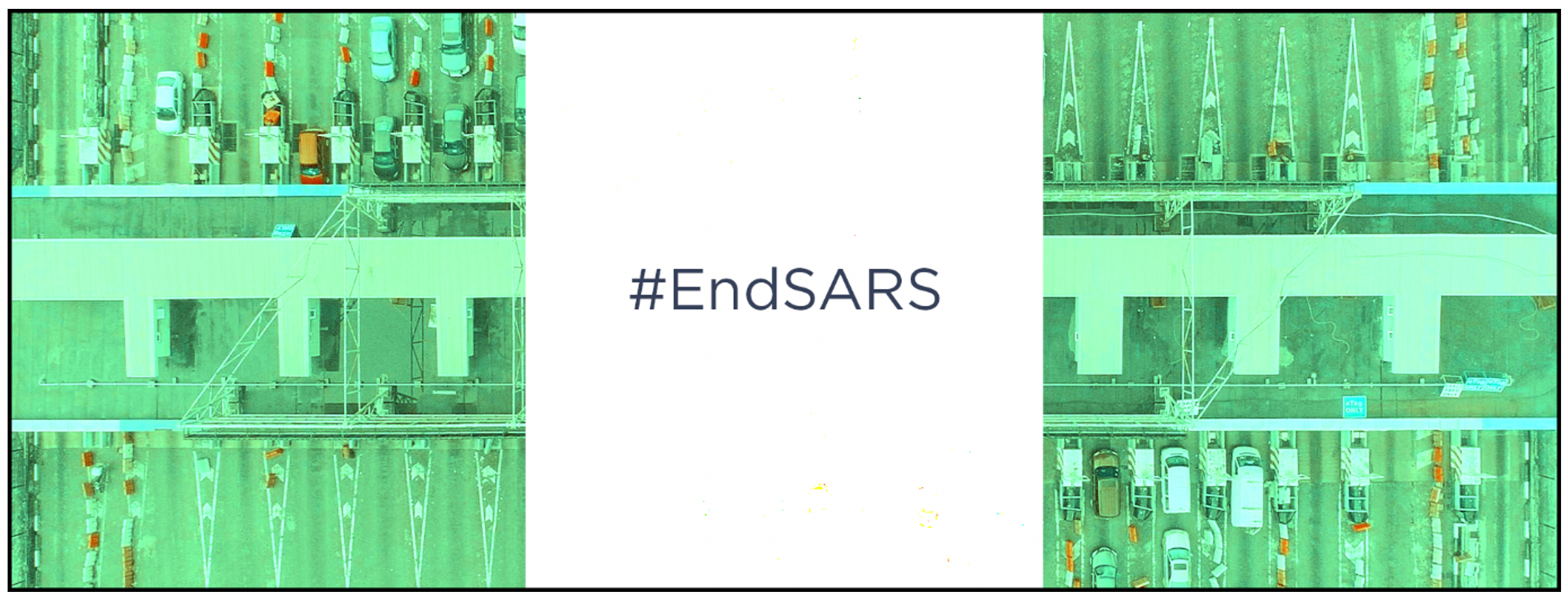
Note: this story contains links to graphic footage.
The Nigerian Army took to Twitter on October 21, 2020 to deny reports that soldiers opened fire against peaceful protestors during an incident the previous day. Despite eyewitness accounts, video footage and several news reports, the army’s Twitter account labeled several local and international publications reporting on the shooting as “fake news.”
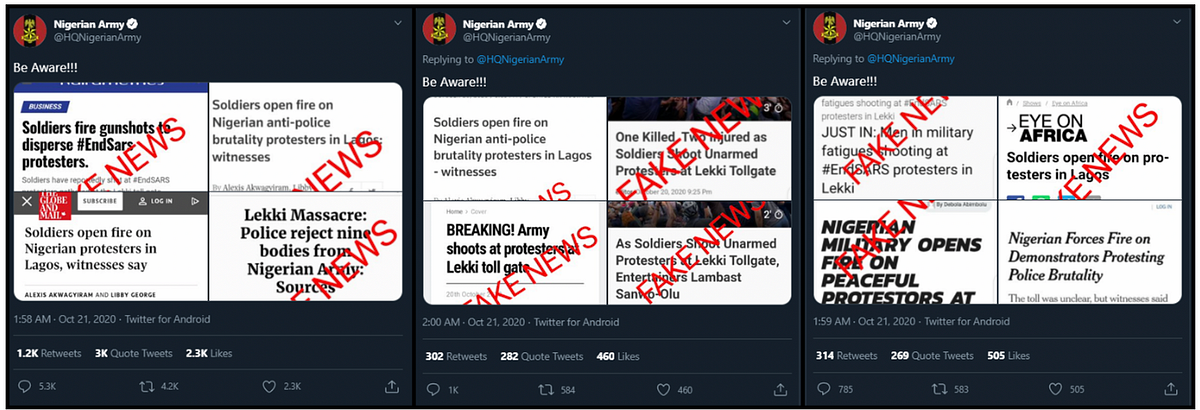
Nationwide demonstrations have entered their third week, running parallel to a massive social media campaign under the #EndSARS hashtag. Protests were sparked by the alleged shooting of a Nigerian man by the Federal Special Anti-Robbery Squad (FSARS), a Nigerian law enforcement unit at the center of claims of police brutality and torture. But as protesters take to the streets, the Nigerian government has responded to demonstrations with fatal force.
Despite the Nigerian military’s denials, Babajide Sanwo-Olu, governor of Lagos State, identified 29 injuries as a result of the shooting but stopped short of mentioning any fatalities. Sanwo-Olu called the “unfortunate shooting incident” the “toughest night of their lives,” and his tweets suggested the orders came from the Federal Nigerian government. He also instituted a fact-finding committee to investigate the Nigerian Army’s rules of engagement, all of which calls into question the reaction from the Nigerian military.

Open source evidence also contradicts these denials. Several videos corroborate the location and presence of Nigerian soldiers at the Lekki Toll Plaza, a major toll highway toll concession in the south of Lagos. Video footage posted on Twitter place Nigerian soldiers at the plaza, where they are seen approaching peaceful demonstrators and opening fire. Subsequent footage shows injured civilians being carried away from the same location.
Amnesty International reported on October 22 it had received credible reports of deaths as a result of the incident, while the Nigerian military has yet to send out a formal press statement on the events. On the evening of October 22, Amnesty confirmed that at least 12 protesters had been killed, 10 of which relate to the Lekki shooting.
U.S. Secretary of State Mike Pompeo issued a press statement on the morning of October 23, condemning the use of force by military forces against unarmed demonstrators.
Background
Scores of Nigerian youths embarked on the protest at Lekki Toll Plaza in the southern part of Lagos, Africa’s most populous city, early on the morning of October 20. The demonstration was the latest in a series of nationwide protests against police brutality.
This iteration of the #EndSARS campaign was sparked by claims on October 3 that a young Nigerian man was shot and killed by FSARS members near the Wetland Hotel in Ughelli, 100 miles northeast of Port Harcourt. Tweets alleged that FSARS members sped off with the man’s white SUV after the fatal shooting. Young, affluent-appearing Nigerians, colloquially referred to as “Yahoo boys,” are often profiled and targeted by law enforcement for little more than their appearance.
The facts around this incident appear unclear; although initial reports claimed that the individual was shot and killed by FSARS soldiers, the vehicle seen fleeing the scene was from a paramilitary unit known as Delta Safe rather than FSARS. None of the viral videos showed the victim being shot, nor were any gunshot wounds apparent on the footage either.
Official reports following the incident also contradicted the video: Festus Keyamo, junior minister for labor in Delta State where the incident took place, told The Guardian and BBC publications that the victim had not been shot by law enforcement, but sustained head injuries after he jumped from a moving vehicle. Keyamo visited the victim and his brother the next day, and shared a picture of the victim recovering in hospital.
Regardless of the veracity of this initial incident, the video sparked a surge of similar posts and videos from other people showcasing the police brutality exerted by Nigerian law enforcement and FSARS in particular. Variations of the hashtags #EndSARS and #SARSMustEnd trended over the following days while young people — the largest demographic group in Nigeria — organized national protests in several cities.
Social media
The scale of the #EndSARS movement on social media is massive. Using Meltwater Explore, the DFRLab tracked the volume of a series of hashtags associated with the #EndSARS campaign over time. The initial peak from October 3–4 initiated by the Wetland Hotel video was dwarfed by the volumes seen after sit-in protests started on October 8.

Celebrities such as Kanye West, Cardi B and football player Mezut Ozil tweeted their support for Nigerians. These tweets thrust the hashtag and the demands of Nigerians into the spotlight; even Twitter CEO Jack Dorsey endorsed the #EndSARS hashtag and shared links to an organization supporting the protestors with water and food.
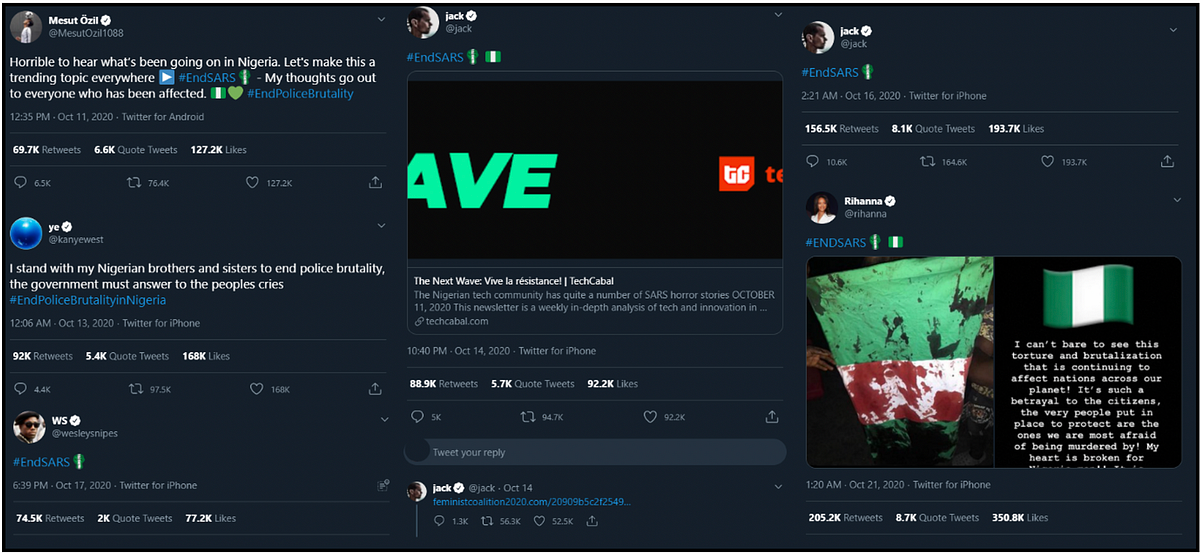
The scale of the #EndSARS campaign becomes apparent when compared to other notable events. In the first 14 days, #EndSARS and its related hashtags saw 18 times more mentions than the August 4 Beirut explosion over the same period, with 173 billion impression (and climbing) for the campaign dwarfing the 29.3 billion impressions for the Beirut blast.
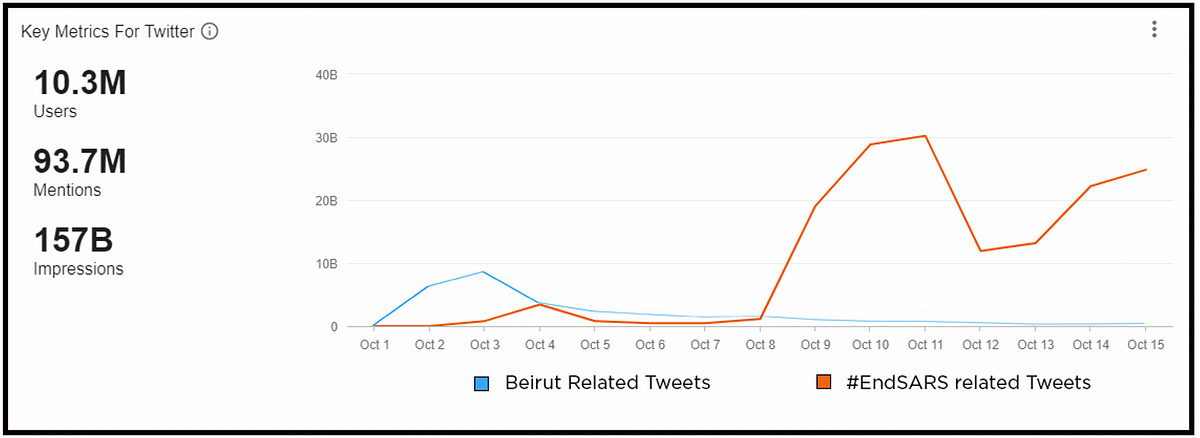
These volumes show no signs of abating, as more attention is drawn to the demands of Nigerians while authorities clamp down violently.
Lekki Toll Gate
The protest staged at the Lekki Toll Gate was initially slated as a three-day event. Protestors converged on the toll gate, set in the south of Lagos near the prestigious Lagos Island, on October 8. Simultaneous protests were also scheduled to take place in other cities too, including Abuja and Ibadan.
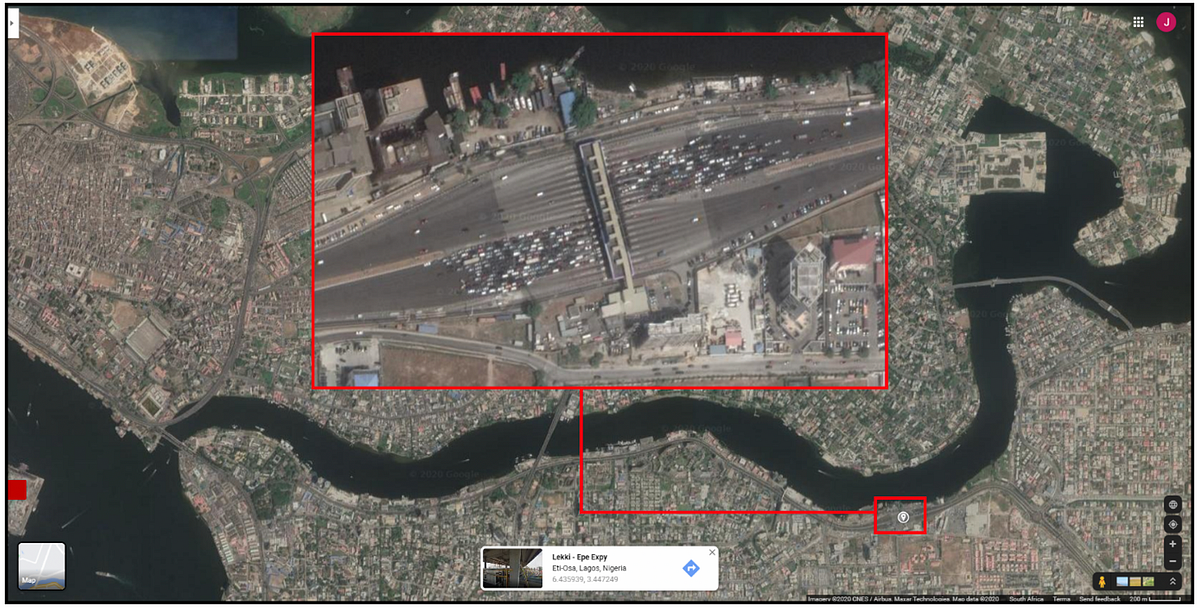
The protest became a multi-day event as protesters erected tents, held religious services and organized food, water and even a music concert. Nigerian media reported that the protests resulted in a loss of N26.6 million naira (USD $70,000) per day. In addition to the closure of the toll gate itself, the diversion of the 80,000 vehicles that use the toll gate daily necessitated the opening of the nearby Lekki-Epe Expressway to ease gridlocked traffic.
Despite the heavy revenue losses incurred by Lagos authorities, the protests were peaceful; videos throughout October 8 to just prior the shooting showed protesters dancing behind the erected barriers, sitting on the road, or engaging in religious activities. Some of the last videos and images shared before the shooting showed protesters singing the national anthem.
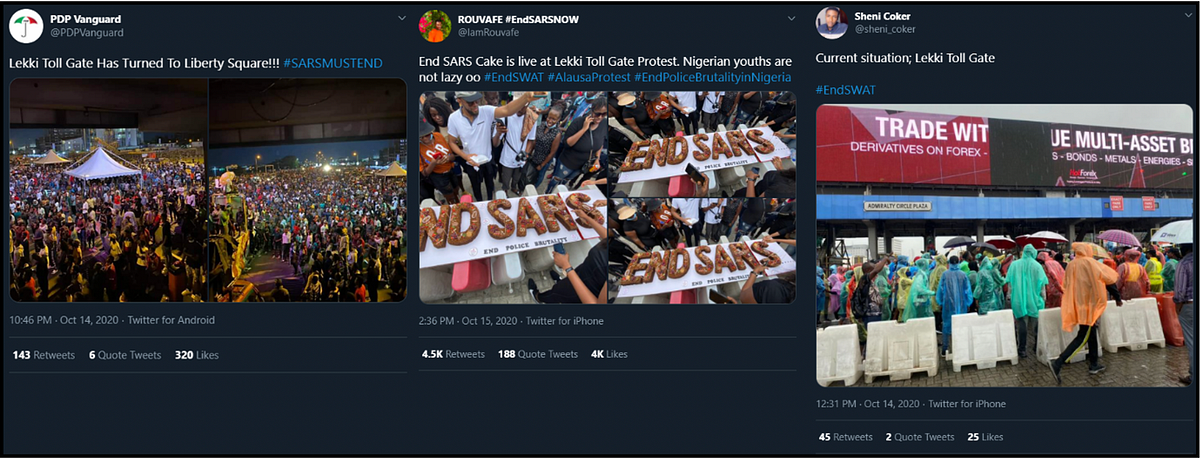
But just before noon local time on October 20, Lagos State Governor Sanwo-Olu announced a 24-hour curfew to curb violent and criminal elements that he claimed were hiding within the protests after two police stations were burned down. Twitter users urged the Lekki Toll Gate protesters to heed the curfew starting at 4 PM local time.
At 5:03 PM, an unverified post on Twitter claimed that toll gate security cameras had been removed allegedly by a government official. The logo present on the individual’s workwear indicated that he is an employee of Lekki Concession Company (LCC), the entity managing the toll gate on the city’s behalf.

Similarly, the angle of the shadows cast by objects in the photograph would place the individual at the northern section of the toll plaza, near the booths servicing traffic headed in a western direction. These shadows are closely aligned enough with the time of the tweet to corroborate the information.
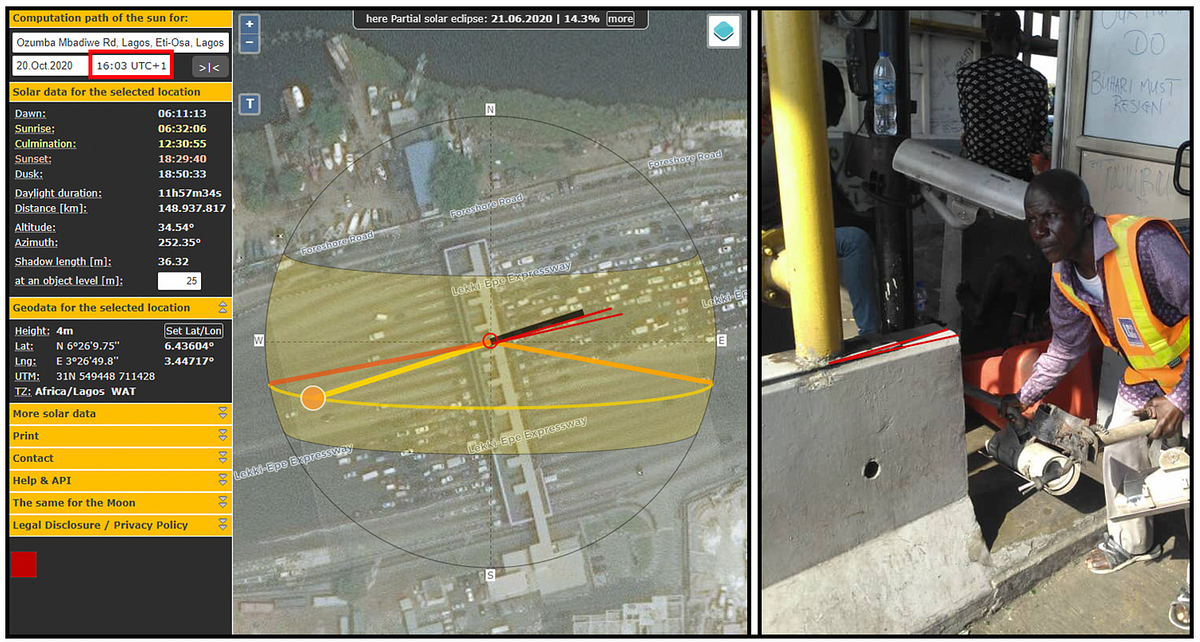
As images of the removed security cameras spread, it prompted further warnings from Twitter users to vacate the protest, citing the removal of the cameras as an indication of ill intent on the part of the Nigerian government.
The first references to the shooting occurred at 6:42 PM, followed by several similar posts identifying gunshots in the vicinity of the toll gate. Witnesses indicated that “police” arrived in 10 trucks at around 6:42 local time. This closely corroborates the Amnesty International findings, which found soldiers began shooting at 6:45 PM.

Geolocating the Shooting
The DFRLab used four videos to geolocate the shooting to the Lekki toll gate. These videos also confirmed Nigerian soldiers were in the presence of injured protesters in the vicinity of the toll gate.
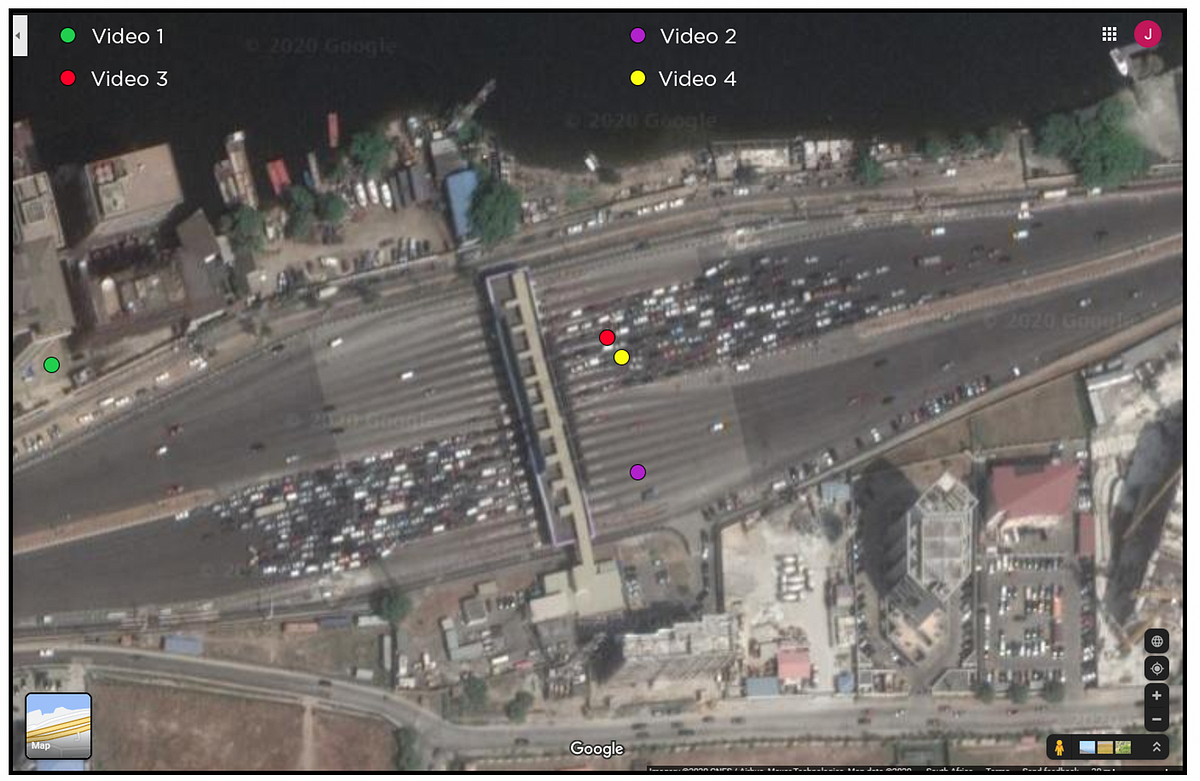
Despite denials by the Nigerian military, video’s posted on social media clearly show Nigerian soldiers approaching the crowd where they remained behind the barriers. Several shots are fired, many of them in the air based on the muzzle flashes. In one of these videos, law enforcement vehicle approached protestors from the west as they opened fire.

A different video shows what appears to be soldiers of the Nigerian army approaching protesters where they were stationed behind plastic barriers. Soldiers approached the group and opened fire. No warning is heard in the video. Muzzle flashes indicate that several of the shots seen and heard here were fired into the air.

From a geolocation of the video, features near the toll gate and across the channel on Lagos island confirmed it was taken looking into a northern direction on the eastern part of the toll gate, suggesting that protesters were approached from both the east and west by law enforcement, as suggested by some witnesses.

Video footage also identified injured protestors at the same scene. The author of a video uploaded to Twitter on October 20 shows injured and bloodied protestors with the author claiming they were shot by soldiers. As the video pans, a parking garage to the south of the toll gate can be seen.

Another video taken in front of the toll gate showed several injured protestors being carried off in the presence of camouflaged soldiers, presumably the same soldiers seen in the second video above. At least two protestors are carried away, while a third is seen on the ground during the video.
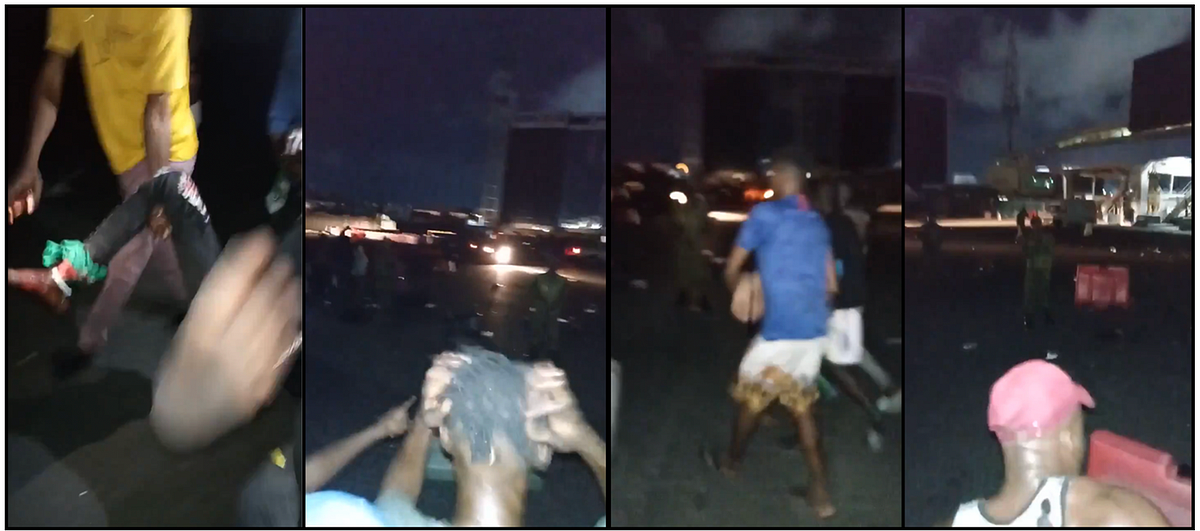
A geolocation of the video places these soldiers on the southern section of the eastern part of the toll gate, the same spot as the soldiers seen opening fire on protestors in the second video above.
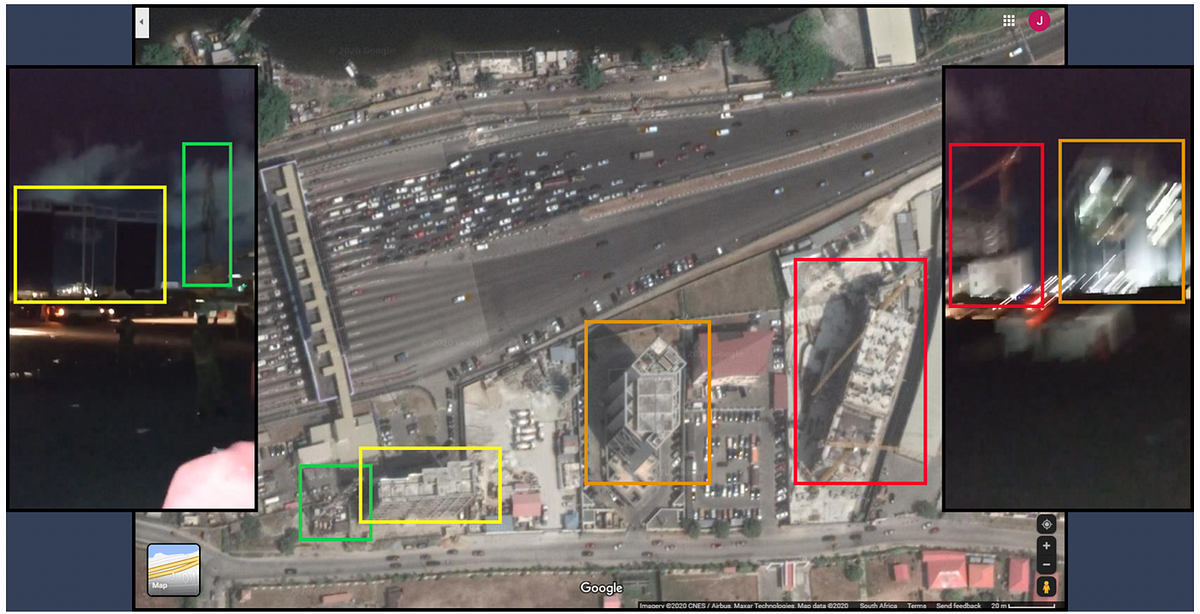
Despite denials by the Nigerian Army, open source evidence links the presence of Nigerian soldiers at the Lekki Toll Gate at the same time as the first reports of shooting came in. Video footage also showed Lekki Toll Gate protestors, who had been peaceful in the preceding 11 days, bloodied and injured in the presence of these soldiers.
Jean Le Roux is a Research Associate, Southern Africa, with the Digital Forensic Research Lab and is based in Cape Town.
The DFRLab team in Cape Town works in partnership with Code for Africa.
Follow along for more in-depth analysis from our #DigitalSherlocks.

